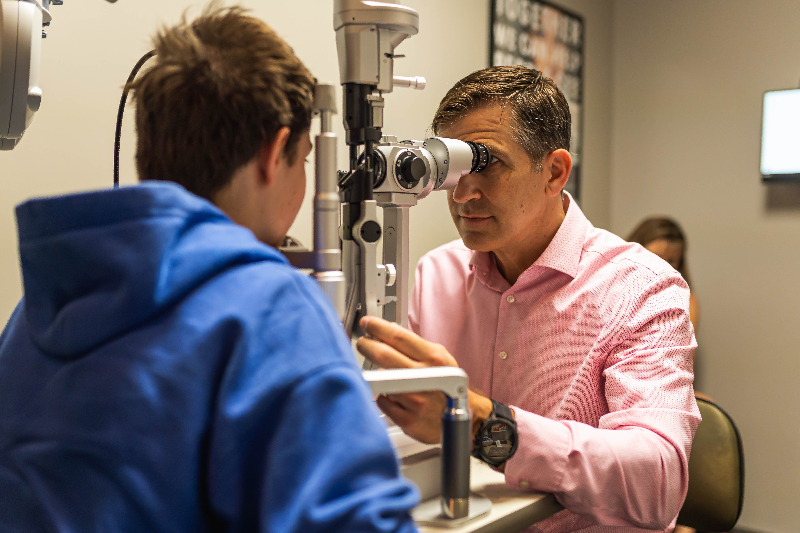- Get in touch!
- See Our Locations
Pediatric Vision Care

Eye exam schedule for kids
Routine comprehensive eye examinations are a crucial part of your child’s well-being and readiness for learning. Many parents do not know that vision screenings at school or the pediatrician's office are not the same as comprehensive eye examinations. Even with 20/20 vision, your child can still have problems that only an eye doctor can detect.
Newborns have their eyes checked before leaving the hospital. And leading medical organizations recommend comprehensive eye examinations for health, vision development, and alignment at these ages:
- Between 6 and 12 months
- 3 years of age
- Every other year throughout the school years
Eye Examinations for Infants, Toddlers and School-Aged Children
A comprehensive eye examination will assess visual acuity, refractive status, ocular health, eye tracking, eye focusing, and eye teaming. Visual acuity measures how clearly a child sees objects. Refractive status measures for nearsightedness (myopia), farsightedness (hyperopia), and astigmatism. Children are evaluated for eye health problems, including active pathology or congenital anomalies.
Eye tracking is the ability of the eyes to fixate, smoothly follow and look between objects or printed words. Eye focusing is the ability to efficiently change and sustain focus while reading. Eye teaming is the ability to coordinate both eyes accurately and without fatigue or excessive effort. Accurate eye teaming is also important for depth perception or stereopsis. Early detection and management is recommended to prevent vision loss or eye disease and to provide appropriate vision development.
To learn more about how the examination process differs for infants, preschool, and school-aged children visit the links.
Give your child the gift of clear vision today.
Support your child's highest potential.
Vision in the broadest sense, is the global ability of the brain to extract, process, and act on information presented to the eye. There are three major areas that are responsible for this complex process:
- visual acuity, which is largely dependent upon refractive status and eye health
- visual efficiency skills, representing eye focusing, teaming, and tracking skills
- visual information processing, representing the ability to recognize and discriminate visual stimuli and to interpret them correctly based upon previous experience.
Our doctors carefully consider each one of these three elements at every examinationwe provide for children, regardless of the child's age
Healthy vision is one of the most important components of your child’s wellness. Vision develops rapidly starting at birth and is tied to many developmental milestones, such as hand-eye coordination and reading. In the long term, your child’s vision will impact how they learn, play, and interact with the world.
While there may be some obvious signs of visual disorders, many vision problems can only be detected by a qualified eye doctor during a comprehensive eye exam.
Is your child having trouble seeing?
It is not always easy to spot vision problems in kids.
Some symptoms are more obvious, like squinting or holding reading materials very close. But often, the early signs are subtle and can even be misdiagnosed.
Your child may be experiencing a vision problem if he or she does any of the following:
- Avoids reading and close-up work like coloring or doing puzzles
- Seems to work slowly or not understand the task
- Complains of fatigue or headaches
- Has a short attention span or seems distracted
- Covers one eye or tilts their head when focusing on something
- Shows sensitivity to light
- Exhibits difficulty with coordination
Infants
Our infant vision examinations start in early infancy and continue through the school years. Although young children may not be able to read an eye chart, special procedures have been developed that allow us to measure the clarity of sight of children at almost any age. “The American Optometric Association guidelines recommend that all children have a complete vision and eye health examination at the age of 6 months, 3 years, upon entering kindergarten, and routine vision care (every 2 years) thereafter throughout their school years.” (http://www.aoa.org)
School Performance
Many vision problems can be corrected more easily with early diagnosis and treatment. Reports have estimated that up to 25% of students in Grade K - 6 have vision-related problems, which may contribute to poor school performance. The visual system matures rapidly during the first few years of life, and it is important to identify any problems that may interfere with normal vision development.
Hand-Eye Coordination
As part of the visual examination, we also assess vision development. Young children use vision to explore the world by identifying and detecting movement. If a problem in vision is preventing adequate development of perception and eye-hand coordination skills, then early intervention is vital.
Common eye disorders in children
Vision can be affected by many things, including the shape of the eyeball, how the eyes and brain work together, and by other diseases or medical conditions. The good news is that many eye disorders can be successfully identified and treated when detected early.
The most common eye disorders are caused by the shape and alignment of the eyes, including:
- Strabismus: when the eyes do not align properly. This is often referred to as "crossed eyes."
- Amblyopia: poor vision in one eye, and sometimes referred to as "lazy eye." It usually occurs before the age of eight. Infants born prematurely or with low birth weight are at greater risk.
- Refractive errors: blurry images caused by the shape of the eyeball or lens. These common conditions are easily treated with glasses or contact lenses. There are three types of refractive errors:
- Myopia, or nearsightedness
,is good up-close vision but poor distance vision. - Hyperopia, or farsightedness, is poor up-close vision. Distant objects can usually be seen with much less effort.
- Astigmatism is imperfect vision at any distance
- Myopia, or nearsightedness
Support your child's highest potential today.
Schedule an appointment today at one of our convenient locations!


